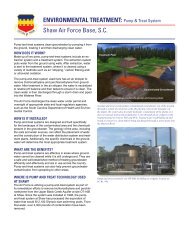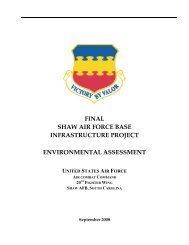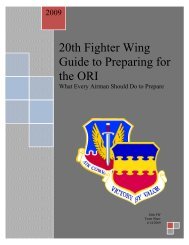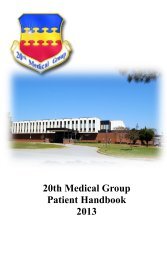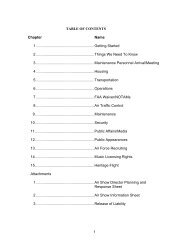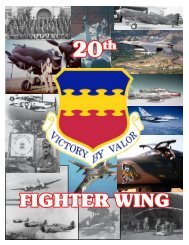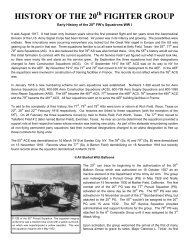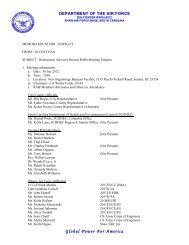20th
HISTORY OF THE 20th FIGHTER WING - Shaw Air Force Base
HISTORY OF THE 20th FIGHTER WING - Shaw Air Force Base
You also want an ePaper? Increase the reach of your titles
YUMPU automatically turns print PDFs into web optimized ePapers that Google loves.
HISTORY OF THE <strong>20th</strong> FIGHTER WING<br />
Today’s <strong>20th</strong> Fighter Wing (FW) can trace its lineage to the initial creation, on Jul. 28, 1947, of the <strong>20th</strong> Fighter<br />
Wing, organized (manned) on Aug. 15 of the same year at Shaw Field, South Carolina, as a Ninth Air Force<br />
unit. Components of the new fighter wing included the <strong>20th</strong> Maintenance and Supply Group, the <strong>20th</strong> Airdrome<br />
Group, and the <strong>20th</strong> Station Medical Group (later Tactical Hospital). At the same time, the 20 FG with its 55, 77,<br />
and 79 FSs and P-51 Mustangs formed the combat element of the <strong>20th</strong> FW. The group exchanged its P-51s in<br />
February 1948 for P-84B (later D) Thunderjets.<br />
On Aug. 24, 1948, a reorganization of the <strong>20th</strong> Maintenance and Supply Group featured the activation of the <strong>20th</strong><br />
Supply Squadron, Fighter, Jet (later simplified to <strong>20th</strong> Supply Squadron) and the <strong>20th</strong> Maintenance Squadron,<br />
Fighter, Jet (renamed <strong>20th</strong> Maintenance Squadron in 1950, <strong>20th</strong> Field Maintenance Squadron in 1954, and <strong>20th</strong><br />
Equipment Maintenance Squadron in 1981).<br />
Two days later, on Aug. 26, 1948, the wing’s <strong>20th</strong> Airdrome Group was discontinued and its security police (now<br />
the <strong>20th</strong> Security Police Squadron), installations, food service and air base elements became realigned under<br />
the <strong>20th</strong> Air Base Group. The creation of the new group fostered the activation of the <strong>20th</strong> Finance Disbursing<br />
Unit (today’s <strong>20th</strong> Comptroller Squadron), the <strong>20th</strong> Motor Vehicle Squadron (predecessor of the <strong>20th</strong> Transportation<br />
Squadron), the <strong>20th</strong> Installations Squadron (redesignated <strong>20th</strong> Civil Engineering Squadron fourteen years<br />
later), the <strong>20th</strong> Food Service Squadron (antecedent of the <strong>20th</strong> Services Squadron), and the <strong>20th</strong> Communications<br />
Squadron (no relation to the communications organizations serving the wing today).<br />
<strong>20th</strong> Becomes Fighter Bomber Wing<br />
Control over the wing changed hands on Feb. 1, 1949 with its assignment to the Fourteenth Air Force. Eleven<br />
months later, on Jan. 20, 1950, the wing was redesignated as the <strong>20th</strong> Fighter Bomber Wing (FBW). Similar<br />
redesignations altered the titles of the <strong>20th</strong> Group and its three flying squadrons.<br />
Front Row L-R: Capt. Tom Ross (USMC exchange officer),<br />
Maj. Delynn E. Anderson (CO 79th FS), May Jacobson, Maj.<br />
Alan Armstrong (USMC exchange officer), Col Dunning (CO<br />
<strong>20th</strong> FG), Col Cy Wilson (ex <strong>20th</strong> FG CO WW II on loan from<br />
Pentagon for Fox Able deployment). 2nd row: Lt. Col. Mitchell<br />
(CO 55th FS). Briefing for deployment to RAF Manston in<br />
Shaw Base Theater. Many in this picture became important<br />
leaders for developing jet fighter operations, and for Korean<br />
and Vietnam combat. The future was here!<br />
The Korean War had just begun. USAF plans had been<br />
to send the SAC 12th FW to England to bolster the forces<br />
in Europe. But the Cold War got hot before the 12th’s<br />
F-84s were ready to go. The <strong>20th</strong>’s Director of Operations<br />
was called from a Saturday night party at the club<br />
to take a message that the <strong>20th</strong> was going to England.<br />
The <strong>20th</strong> had about seven days to get ready. Getting<br />
ready included receiving a set of two-230 gallon tip tanks<br />
for each airplane to replace the two-185 gallon tanks that<br />
had been provided with their F-84Ds. On Jul. 19, 1950<br />
the <strong>20th</strong> Fighter Bomber Group (FBG) under the command<br />
of Col. John Dunning executed the first movement<br />
of a full jet fighter group to Europe. The <strong>20th</strong> flew their<br />
F-84Ds from Shaw AFB to Dow AFB Maine. At Dow AFB<br />
a message was received to remove personal baggage<br />
from the .50 cal. ammunition compartments so that live<br />
ammunition could be loaded. Headquarters felt there<br />
was a strong possibility that the Soviets would try to interfere<br />
with the movement of the unit to England. The<br />
<strong>20th</strong> would then continue on its movement without Soviet<br />
action via Goose Bay Labrador, Bluie West One, Greenland,<br />
Keflavik, Iceland, Kinross, Scotland and finally to<br />
Manston, England. Half way between Greenland and<br />
<strong>20th</strong> Fighter Wing History --- Page Number 16.



